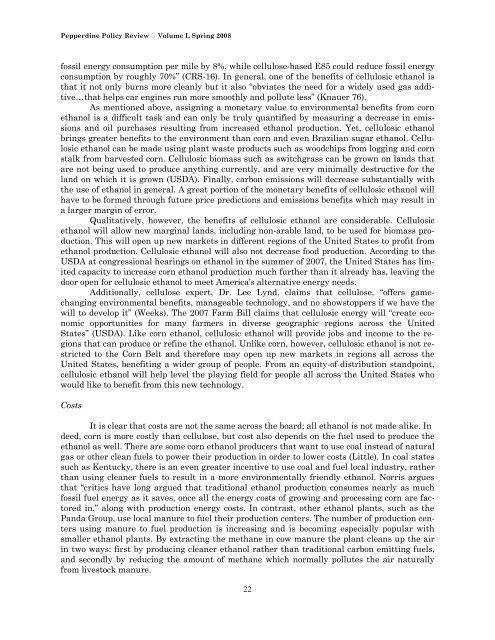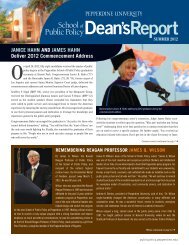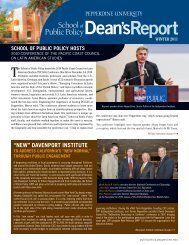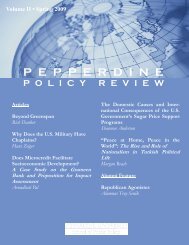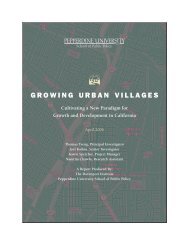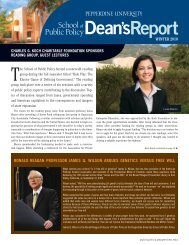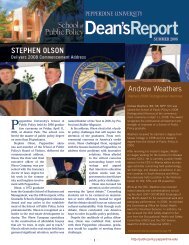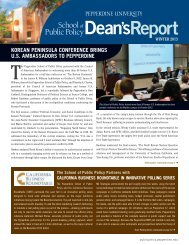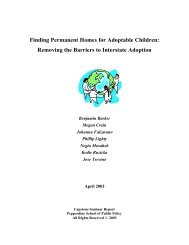Pepperdine University School of Public Policy
Pepperdine University School of Public Policy
Pepperdine University School of Public Policy
You also want an ePaper? Increase the reach of your titles
YUMPU automatically turns print PDFs into web optimized ePapers that Google loves.
<strong>Pepperdine</strong> <strong>Policy</strong> Review Volume I, Spring 2008<br />
fossil energy consumption per mile by 8%, while cellulose-based E85 could reduce fossil energy<br />
consumption by roughly 70%” (CRS-16). In general, one <strong>of</strong> the benefits <strong>of</strong> cellulosic ethanol is<br />
that it not only burns more cleanly but it also “obviates the need for a widely used gas additive…that<br />
helps car engines run more smoothly and pollute less” (Knauer 76).<br />
As mentioned above, assigning a monetary value to environmental benefits from corn<br />
ethanol is a difficult task and can only be truly quantified by measuring a decrease in emissions<br />
and oil purchases resulting from increased ethanol production. Yet, cellulosic ethanol<br />
brings greater benefits to the environment than corn and even Brazilian sugar ethanol. Cellulosic<br />
ethanol can be made using plant waste products such as woodchips from logging and corn<br />
stalk from harvested corn. Cellulosic biomass such as switchgrass can be grown on lands that<br />
are not being used to produce anything currently, and are very minimally destructive for the<br />
land on which it is grown (USDA). Finally, carbon emissions will decrease substantially with<br />
the use <strong>of</strong> ethanol in general. A great portion <strong>of</strong> the monetary benefits <strong>of</strong> cellulosic ethanol will<br />
have to be formed through future price predictions and emissions benefits which may result in<br />
a larger margin <strong>of</strong> error.<br />
Qualitatively, however, the benefits <strong>of</strong> cellulosic ethanol are considerable. Cellulosic<br />
ethanol will allow new marginal lands, including non-arable land, to be used for biomass production.<br />
This will open up new markets in different regions <strong>of</strong> the United States to pr<strong>of</strong>it from<br />
ethanol production. Cellulosic ethanol will also not decrease food production. According to the<br />
USDA at congressional hearings on ethanol in the summer <strong>of</strong> 2007, the United States has limited<br />
capacity to increase corn ethanol production much further than it already has, leaving the<br />
door open for cellulosic ethanol to meet America’s alternative energy needs.<br />
Additionally, cellulose expert, Dr. Lee Lynd, claims that cellulose, “<strong>of</strong>fers gamechanging<br />
environmental benefits, manageable technology, and no showstoppers if we have the<br />
will to develop it” (Weeks). The 2007 Farm Bill claims that cellulosic energy will “create economic<br />
opportunities for many farmers in diverse geographic regions across the United<br />
States” (USDA). Like corn ethanol, cellulosic ethanol will provide jobs and income to the regions<br />
that can produce or refine the ethanol. Unlike corn, however, cellulosic ethanol is not restricted<br />
to the Corn Belt and therefore may open up new markets in regions all across the<br />
United States, benefiting a wider group <strong>of</strong> people. From an equity-<strong>of</strong>-distribution standpoint,<br />
cellulosic ethanol will help level the playing field for people all across the United States who<br />
would like to benefit from this new technology.<br />
Costs<br />
It is clear that costs are not the same across the board; all ethanol is not made alike. In<br />
deed, corn is more costly than cellulose, but cost also depends on the fuel used to produce the<br />
ethanol as well. There are some corn ethanol producers that want to use coal instead <strong>of</strong> natural<br />
gas or other clean fuels to power their production in order to lower costs (Little). In coal states<br />
such as Kentucky, there is an even greater incentive to use coal and fuel local industry, rather<br />
than using cleaner fuels to result in a more environmentally friendly ethanol. Norris argues<br />
that “critics have long argued that traditional ethanol production consumes nearly as much<br />
fossil fuel energy as it saves, once all the energy costs <strong>of</strong> growing and processing corn are factored<br />
in,” along with production energy costs. In contrast, other ethanol plants, such as the<br />
Panda Group, use local manure to fuel their production centers. The number <strong>of</strong> production centers<br />
using manure to fuel production is increasing and is becoming especially popular with<br />
smaller ethanol plants. By extracting the methane in cow manure the plant cleans up the air<br />
in two ways: first by producing cleaner ethanol rather than traditional carbon emitting fuels,<br />
and secondly by reducing the amount <strong>of</strong> methane which normally pollutes the air naturally<br />
from livestock manure.<br />
22


